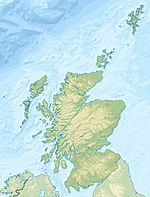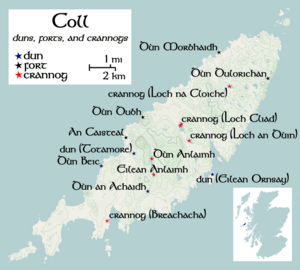Dùn Beic facts for kids
Dùn Beic is an ancient fort, called a dun, found on the island of Coll in the Inner Hebrides. It's believed to have been built a very long time ago, sometime between 1000 BC and 1000 AD.
The name Dùn Beic is a bit of a mystery. Some people think "Beic" might mean "peak" or "beak" in Gaelic. Others wonder if it's a personal name, perhaps even linked to an old king named Béc.
Local stories say that Dùn Beic was one of several forts held by Norsemen (Vikings). These Norsemen were supposedly defeated in a big battle by an ancestor of the Macleans of Coll, a famous Scottish clan.
Archaeologists have found interesting things at Dùn Beic, like pieces of flint, burnt animal bones, and parts of decorated potsherds.
Contents
What's in a Name?
The meaning of the name Dùn Beic isn't fully clear. An expert named Erskine Beveridge, who studied old things in the early 1900s, thought that Beic (pronounced "Veyik") could mean "peak" or "beak" in Gaelic.
He also wondered if the name might come from an old proper name. He pointed out that there was a king from long ago, named Béc, who lived around the year 700 AD. This king was part of a group called the Dál Riatan kings.
Exploring the Fort
Dùn Beic is located on the northeast coast of Coll, an island in the Inner Hebrides. It sits on top of a high cliff that is about 18 meters (59 feet) tall, with the sea all around it.
A dun is an old type of fort or settlement. It usually has a round stone wall and is built on a high spot. At Dùn Beic, the old stone wall runs around the edge of the highest part of the cliff. Most of it has disappeared over time, but you can still see some parts of the wall's rocky core and a few outer stones on the east side.
The wall of Dùn Beic seems to have been oval-shaped. It was about 20 meters (65 feet) long from northeast to southwest and about 15 meters (49 feet) wide.
In 1903, Erskine Beveridge said he found small remains of several buildings on the top of the fort. He even dug a hole in one and found small, round stones. When other experts visited the site in 1972, they didn't see these buildings. However, they did find a rectangular hollow, which they thought might have been Beveridge's excavation spot.
Later, in 1980, another group visited. They noticed that much of the fort's top was too rocky for people to live on. They believed there was only one main building, and only its foundations remain today. This building was about 7.6 by 4.6 meters (25 by 15 feet). Its walls were about 0.6 meters (2 feet) thick. There was an entrance near the middle of the northeast wall.
At the northern end of the site, a small landslip showed that the soil contained some burnt bone and pieces of pottery. This soil had built up to about 0.6 meters (2 feet) deep before the rectangular building was constructed.
Below the cliff on the east side, there's a natural gully (a small valley) in the rock. Beveridge thought this might have been made stronger by people, but later visitors didn't find proof of this. Experts also couldn't find a clear entrance to the fort, but they guess it was in the northeast.
What Was Found There?

In 1903, when Erskine Beveridge dug at Dùn Beic, he found several small, round or oval stones. He noted that these types of stones were often found at other forts on Coll and a nearby island called Tiree.
Along the southwest edge of the fort, Beveridge also found more of these pebbles, along with many pieces of hammerstones (stones used for hammering) and pottery. Some of the pottery had "well patterned" designs. He also found two pieces of flint, though he said they were rough and not very good quality. Flint finds were rare at forts on Coll and Tiree.
When the Ordnance Survey team visited in 1972, they found many pieces of pottery, especially on the western side. They even found parts of a flat-bottomed pot. Another piece of pottery they found was decorated with horizontal lines. These pottery pieces were similar to the rough, gritty pottery found in other places on Coll.
Later, in 1975–76, some Iron Age pottery pieces and slag (waste from metalworking) from Dùn Beic were given to the National Museum of Scotland. Another person, M. W. Holley, found more pottery pieces on the surface, including four decorated rim pieces inside the fort.
North of Dùn Beic, there are remains of old field walls and signs that the land was once farmed. This shows that people lived and worked in the area around the fort not too long ago.
Dùn Beic in Old Stories
For many years, people on Coll have told stories about the old forts on the island, and Dùn Beic is part of these legends.
One popular story was written down by Rev. John Gregorson Campbell in 1895. It tells of the Laird of Duart, a powerful chief, who was sailing to Tiree to collect rent. He sent someone to Coll for food. The woman of the house said the Laird wasn't worth sending food to because he hadn't taken Coll for himself.
She explained that three brothers from Lochlann (a name often used for Norway or Viking lands) controlled Coll at that time. One, named Big Annla, lived in a fort called Loch Annla. Another lived in Dùn Beic, and the third lived in a fort on Grisipol hill. The woman also said she had thirty men ready to fight.
The Laird of Duart then went alone to Big Annla's fort. He was welcomed, but he cleverly managed to sneak away with Annla's arrows. This led to a fight at a place called Grimsari. This story is sometimes seen as the reason why the Laird of Duart encouraged Iain Garbh to take control of Coll.
According to Erskine Beveridge, the forts mentioned in this story are Dùn Anlaimh, Dùn Beic, and Dùn Dubh. Iain Garbh, mentioned in the story, is believed to be the ancestor of the Macleans of Coll.
Beveridge also heard another version of the Norsemen story directly from people on Coll. In this version, the events were said to have happened in 1384. However, he thought this date might have been calculated much later.
Another similar version of the story was published in 1922. It says that Maclean of Duart was told by a woman on Coll that he wasn't worthy of food as long as Norsemen controlled the island. So, he attacked the three Norse brothers who held Coll, including Amlamh Mór at Dùn Anlaimh, another at Dùn Beic, and a third at Dùn Dubh. The big fight happened at Grimsary.
These stories show how important Dùn Beic and the other forts were in the history and legends of Coll.
Images for kids




